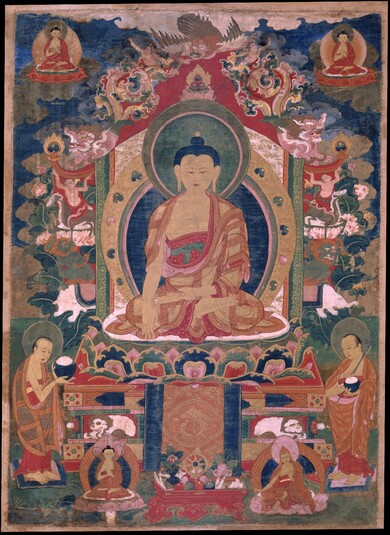
Item: Shakyamuni Buddha - Shakyamuni
| Origin Location | Tibet |
|---|---|
| Material | Ground Mineral Pigment on Cotton |
| Collection | Robert and Lois Baylis |
Classification: Person
Appearance: Buddha
Gender: Male
Shakyamuni Buddha (Tibetan: sha kya thu pa. English: Sage of the Shakya Clan) along with the Sixteen Arhats, Two Attendants and the Four Guardians of the Directions.
Sanskrit: Buddha Shakyamuni Tibetan: Sang gye sha kya tu pa
Tibetan: Sang gye sha kya tu pa
At the top left is Dipamkara Buddha; the buddha of the past. At the top right is Maitreya; the buddha of the future. At the bottom left is Arya Nagarjuna the founder of the Madyamaka system of Buddhist philosophy. At the bottom right is Arya Asanga the founder of the Yogacharya system of Buddhist philosophy.
Arhat (Tibetan: ne tan): a Sanskrit term for Buddhist saints representing the earliest followers of the Buddha, always found in a group of sixteen, they are painted on cloth, wall murals, and fashioned of metal, stone, clay, or wood. An early iconographic source for the individual descriptions of the arhats is the verse text Praise to the Sixteen Arhats attributed to the Kashmiri teacher Shakyashri Bhadra of the 12th/13th century.
The full group of arhats always has twenty-five figures: the Buddha Shakyamuni, together with the two foremost disciples - Shariputra and Maudgalyayana, the sixteen Arhats, the attendant Dharmata, the patron Hvashang and the Four Guardians of the Directions; Vaishravana, Virupaksha, Dhritarashtra and Virudhaka. In all an extensive set of paintings would comprise twenty-three individual paintings. The two foremost disciples are always portrayed in the same painted composition with Buddha Shakyamuni.
Jeff Watt 6-2009
Front of Painting
English Translation of Inscription: [Sanskrit] Dipamkara. Maitreya.
Wylie Transliteration of Inscription: mar me mdze. byams pa.
Shakyamuni Buddha: Main Page
Collection of Robert & Lois Baylis
Painting Set: Arhat Set IV: Baylis Collection
Shakyamuni Buddha: Arhat Sets

